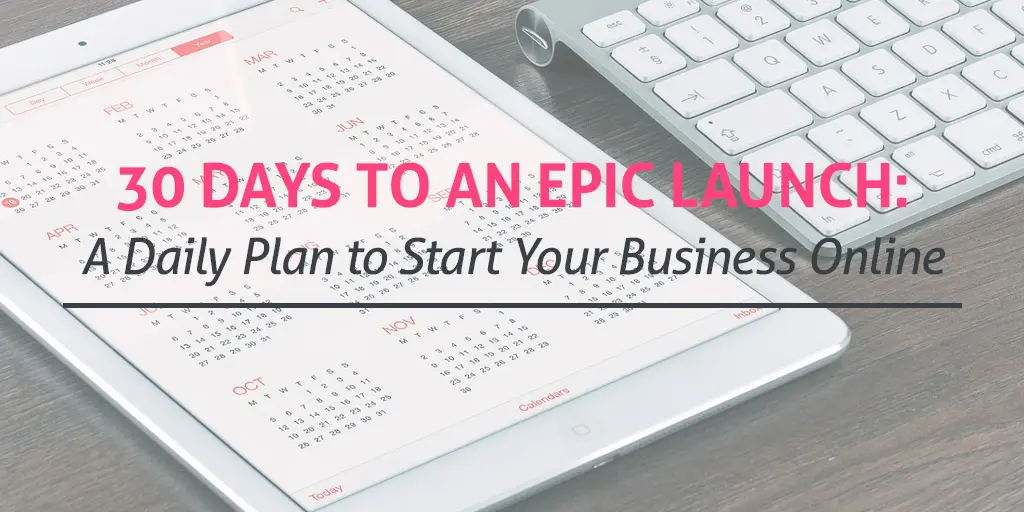
I’m proud of you. You’re actually doing something that most of us dream about, but never make happen in our lifetime—you’re launching a business.
And there’s a good reason most of us don’t start a business. It’s not for the faint of heart. There’s so much that goes into a successful launch, and it can be overwhelming to know what to do first and then what to do next. And like most things in life.
Launching a business doesn’t come with an instruction manual—until now. Click To Tweet
Below, we’re going to share a comprehensive daily plan for launching your business, starting at the very beginning.
Keep in mind that you can do this at your pace. If you can hustle and make this happen in 30 calendar days, mazel tov! If you prefer to spread this daily plan over the course of several months, we’re still going to party like it’s your birthday come launch day.
Consider this your thorough guide to launching in style. Let’s get to it. (We’ll pick up immediately after you’ve developed and validated your business idea.)
Day 1
Secure a domain name. Keep in mind that your domain name does not have to be the same as your product or brand name. In fact, it’s getting increasingly harder to find an available .com domain nowadays, so you may need to get creative. One idea is to add a “Get” + Product Name, such as GetDrip.com.
If a .com isn’t important to you, consider going with an .io domain name. You’ll have more flexibility in name choices. But, keep in mind, some of us like to add salt and .com to everything so an .io domain name may not be the best option, depending on your audience.
Day 2
Hire a writer. This may sound like a strange step, but it’s a crucial one that very few startups consider. Unless you’re good at copy and content writing, you need to hire someone who can do a lot of that for you. A writer can create content for your website, and a particularly versatile one can also create blog posts and content for your landing pages, newsletters, and social media.
It’s a worthwhile investment. Sure, you can do it yourself (especially if you check out this guide), but when you’re launching quick, it’s best to hand that off to someone else so you can focus on other things.
But here’s a note—don’t hire someone from Fiverr or some other mill where you’re basically throwing pennies at a writer to create the heart of your content marketing. Remember: you get what you pay for. steps off soapbox
Day 3
Choose a mail delivery service. While you shouldn’t pinch pennies when it comes to a writer, you can pinch pennies elsewhere. One of the best mail delivery services around is absolutely free (up to 2,000 subscribers), and it goes by the name of MailChimp.
I absolutely adore MailChimp because it’s easy to use and it gets the job done quickly and efficiently.
You’ll need to have your email delivery service ready to go before launching your website so that when people start trickling in, you have a way to collect their emails and send them something right away. That something can be a “thanks for joining” or even a series of emails (more about this later).
Day 4
Create a pre-launch page. You don’t have to create a full website yet. One page with a countdown timer and an email list sign up will do just fine.

Here at KickoffLabs, it’s so easy to create a launch page. We have over 60 different landing page templates you can choose from, many of which are optimized for launch (countdown timer included).
By the way, don’t forget to add a thank you page.
Day 5
Create an email autoresponder. This is basically a welcome email that arrives after someone subscribes to your list. You should set their expectations for how often they will hear from you (more about that next), and get them excited about your launch.
Day 6
Create 4 subsequent emails. In the weeks leading up to your launch, create a plan to stay in frequent contact with your subscribers. You don’t want them to forget who you are. In these emails, you can share sneak peeks of your upcoming product or website. You can also create exclusive behind-the-scenes videos that inspire a sense of excitement for the upcoming launch. Plan to release an email once a week, but on the week of the launch, twice—once the day before and again on the day of the launch. Also, don’t forget to create another email for a week after the launch where you thank your subscribers for making it (fingers crossed) a success.
Day 7
Set up social media accounts. If you haven’t already, set up social media accounts on the main three platforms (Facebook, Twitter, and LinkedIn). Fill out as much as possible, and start populating it with posts.
It’s not necessary to join every social media platforms. Only join the ones where your ideal customer is likely to hang out. The rest don’t matter, even if it’s one of the more popular platforms.
Day 8
Get social on social media. Start following others, especially those you want to follow you back (but don’t unfollow after they follow you—that’s tacky).
It’s a good idea to use a social media scheduling tool like Buffer or HootSuite. You can create an entire batch of social media posts at once and then use one of the above tools to post at a set schedule.
Day 9
Get active in communities. This is similar to social media. Find out where your ideal customer hangs out and then go there and get active. But don’t just visit once and done, visit frequently, sharing thoughtful ideas with the community. You don’t want them asking, where did you go?

Image Courtesy of HilariousGifs.com
Day 10
Create a video for your product/service. People are much more likely to engage with a video than any other form of content, so it’s a good idea to include an introductory video on your launch and/or landing page. Keep it short (two minutes or less), and focused on what you’re selling.
Day 11
Create a landing page for your product. You’ve created a pre-launch page, but you also need a landing page for the day of (and every day after) your launch. Good news is, we’ve got a template for that. And, we’ve also got a guide for creating a visually compelling landing page that you won’t want to miss.
Day 12
Set up Google Adwords. Google is, by far, the most popular search engine. If you’d like to get found by its users (80% of the Internet), the easiest way is through paid ads. Consider bidding for a spot near the top of a Google search page results.
If you do go with paid ads, remember to link to an optimized landing page.
Day 13
Set up Bing. Bing is very similar to Google. Start here for Bing.
Day 14
Set up Facebook Ads. If your ideal customer is on Facebook (and it’s highly probable that they are), you should consider buying Facebook ads and targeting them. Facebook ads have the potential to reach one billion people worldwide. It’s definitely worth considering.
Day 15
Gather data from beta testers. Send an email to all of your beta testers and ask them about their experience with your product. Be sure to log that information. You may also be able to gather testimonials from your beta testers.
Day 16
Create a website. You can go with WordPress or Squarespace. You can buy a template or hire a professional to create a website from scratch. Which option you go with doesn’t matter as much as actually creating a website.
Day 17
Buy a business email. None of this “@yahoo.com” or “@hotmail.com” business, please. If you really want people to take your launch seriously, you’ll have a business email address that’s @yourbusinessname.com. No exceptions.

Day 18
Build a press kit. A press kit will give interested parties all the information they need to write about you and your business. In your press kit, include information about your product and share your personal bio. Also include high resolution images of you and your product along with brand logos. Last, but not least, share any relevant case studies you may have.
Day 19
Scout opportunities for guest posting. Make a list of at least 25 of your favorite blogs. These are sites that cater to your same audience but don’t compete with you. Then, reach out to the owners of these sites and pitch them a customized idea that will work for their audience and also give you the opportunity to increase your exposure.
Now, put that writer to work again. This time, have him or her write a guest posts on your behalf.
Last, but certainly not least, make sure you link to your launch page in your guest post bio link. For more on this strategy, check out this post: Boost Your Traffic with this Supersized List of Hacks.
Day 20
Set up a referral or affiliate program. Have you considered partnering with other companies to sell your product(s) once the time comes? Now’s your time to consider setting up a referral program.
Day 21
Run a contest. Contests are an amazing way to get people excited about your startup. Not only will they give you their valuable email address in exchange for an opportunity to win, they’ll also tell their friends about you. What more can you ask for?
Everyone loves a contest.

Image Courtesy of HilariousGifs.com
We’ve actually devoted an entire blog post to this very topic. Check it out if you want to be epic: Why Contests Work (and How to Run One).
Day 22
Look for opportunities on HARO. Ever heard of HARO? It stands for Help a Reporter Out. Basically, reporters, journalists, and bloggers search HARO for people willing to help them complete a story. The requests may range from a quote to an interview. If you’re picked, it means free publicity for your business.
Day 23
Create a press release about your launch. That’s right—we’re kicking it old school and doing a press release. You may be surprised at the amount of traffic a good old fashioned press statement can get you. If you sell it right, your launch will get picked up by journalists and bloggers who are always hungry for a compelling story.

My favorite press release distribution services are PRNewswire and PRWeb. Not sure how to write a press release? That’s why you hired a writer. See—it’s starting to pay off, right?
Day 24
Reach out to influencers to get the word out. Ideally, you will have nurtured a relationship with these influencers way before now. Please don’t ask them to share your launch with their network if you haven’t ever interacted with them before now. Find influencers whose content you’ve actually shared and commented on to reach out to. If you’ve been investing in their community, they will know who you are.
Day 25
Test your website. Did you know that there are people out there who will test your website for free? Check out Peek by User Testing for insanely valuable insight into how people interact with your website. It’s a good way to check your website before unveiling it to the Interwebs.
Image Courtesy of Peek by User Testing
Day 26
Reach out to everyone you know. It’s time to let everyone you’ve ever emailed know that you’re launching your business. Well, maybe not everyone, but just about.
If you can, send the most influential on your personal list a warm, personal note telling them about your upcoming launching and asking for them to help spread the word. Be sure to link to your launch page. Be clear about what you’re selling. Make it easy for them to get the word out to their networks.
While you’re still in your email, change your signature. Add a blurb about your launch (along with a link to your launch page) underneath your name.
Day 27
Do a dry run of the ordering process. While you may not be taking orders until launch day, you definitely don’t want any surprises come launch day. Go through the ordering process yourself on multiple browsers (Chrome, Firefox, Safari, and Internet Explorer) to ensure a smooth ordering process on the day of.
Day 28
Submit your launch and details on popular startup sites such as:
Day 29
Create a “contest ended” landing page. Did you run a contest to promote your launch? Don’t overlook this landing page. While you won’t activate this page until after launch day and the contest has ended, it’s a good idea to have it ready to go. This landing page will keep the link active in case you still have incoming visitors to that URL.
On a “contest ended” landing page, share the winners and also highlight other fun or upcoming events you have planned. Urge them to sign up for your newsletter, too.
Day 30
Launch! All of your hard work has led up to launch day. Get a cup of coffee, open your inbox, and get to work. Congratulations!

Oh, before you go, here’s how to keep your audience engaged post launch.